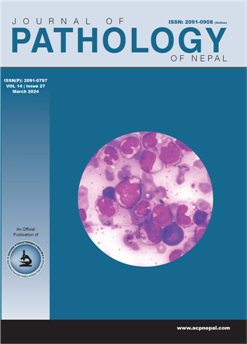Serological profile of voluntary blood donors in a blood bank of tertiary health care centre- An institution-based study
DOI:
https://doi.org/10.3126/jpn.v14i1.56556Keywords:
Hepatitis B virus, hepatitis C virus, human immunodeficiency virus, syphilis, malaria, voluntary donorsAbstract
Background: The safe transfusion of blood facilities is an essential component of an efficient, excellent healthcare sector. Unsafe blood transfusions can be a cause of transfusion-transmitted infections and can be lethal. The present study was conducted to find out the seroprevalence of HBsAg, HCV, HIV, malarial parasites, and syphilis in voluntary blood donors in a tertiary care center.
Materials and methods: This prospective study was conducted at the blood bank of the Shri Mahant Indiresh Hospital, Dehradun. 16413 samples from all blood donations were screened for HBsAg, HCV, HIV 1 and 2, malaria, and syphilis. Samples were collected in vacutainers at the time of blood donation and screened for HIV 1and2, HBsAg, and HCV using the fourth-generation enzyme-linked immunosorbent assay technique. Syphilis was tested by Treponema antibodies using the VITROS Syphilis TPA Reagent Pack. Malaria was tested by pan malaria card, monoclonal anti-pan specific parasite lactate dehydrogenase antibody conjugated to colloidal gold, and another monoclonal anti-pan specific parasite lactate dehydrogenase antibody immobilized on a nitrocellulose strip in a thin line.
Results: Out of 16413 blood donors 342(2.1%) were found to be seropositive and 16071 (97.9%) were found to be seronegative. The total number of donors, who were found positive for HBsAg/Anti HCV was 1 (0.3%). Out of the seropositive cases, HBsAg, HCV, HIV, and Syphilis infections constituted 28.9%, 27.5, 14.6, and 28.7% cases respectively.
Conclusions: There is a need for the development and implementation of stringent donor selection and sensitive screening tests to reduce the risk of acquiring transfusion-transmitted illnesses.
Downloads
Downloads
Published
How to Cite
Issue
Section
License
Copyright (c) 2024 The Author(s)

This work is licensed under a Creative Commons Attribution 4.0 International License.
This license enables reusers to distribute, remix, adapt, and build upon the material in any medium or format, so long as attribution is given to the creator. The license allows for commercial use.




